Cylon Detector
I got to use my cylon detector today
Actually, it is a mold for making a concrete counter weight for my tractor. It helps the tractor by preventing a heavy weight lifted on the bucket arms from lifting the rear tires off the ground. Actually, hopefully, it is heavy enough to transfer some of the weight from the front axle to the rear. The rear of the tractor can handle a lot more weight than the front. It seems odd that the heavy lifting arms are on the front...
The block of cement fits into the three point hitch on the back of the tractor. I used a 3ph draw bar with a bumper hitch mounted on it to attach the weight to the tractor.
The Draw bar and hitch fit into the cavity in the bottom of the block. There is a pair of eight inch long 3/4" bolts embedded in the block that hold it all together.
On the front, there is a receiving hole for the top link.
I also molded a V of rebar into the opposite face as a lifting eye. I am not convinced I embedded it far enough, though, so I haven't used that to lift the block. It makes a great place to hook the trailer's safety chains, though.
I made the counter weight because I was often unloading and moving around heavy bins of material from my trailer. I use a flatbed 5 X 10 trailer for picking up loads of manure and wood chips. Since I use the tractor to get the trailer up into the field where the composting is, I need easy access to to a trailer hitch. If I just need ballast and there weren't the complication of pulling the trailer, I could have just used my box blade as a counter weight. But switching between my trailer hitch and box blade chews up a lot of time. With my new counter weight I can tow the trailer without taking it off. It also means I have the counter weight on when I use the tractor to go across the way to the mill and pickup wood chips. I don't really need the counter weight on for loader work, as I have loaded rear tires. But it helps make the tractor more stable.
And when I am unloading the bins it really makes a difference. Each bin holds three or four bucket loads of material. Even though the bins are far lighter than the bucket, the combined weight of material and bin is enough tip the balance of the tractor. And the bins allow the weight to be further from the front axle, giving it more leverage. It isn't safe, and it isn't good for the tractor. To date I had the choice of partially unloading the bins to keep them light enough or taking the time to switch implements on the 3ph. The new regime is a big improvement.
I still have some work to do. This counter weight is smaller than I really want. It took six ninety pound bags of concrete, so about 540 pounds. I really want a little more than one thousand pounds. The plan is to make a second L shaped block. The L will be inverted and hook onto the original block. That is why there is a lip on the back front of this one. I want to be able to store the next one in a position so I can back up to it slip this one under it and pick it up, doubling my counter weight. That way, I have a reasonable counter weight for loader work and a heavy one for bigger jobs that is quick on and off.
There are a couple things I wish I had done differently. I should have embedded one and better yet two 5/8s rebar rods across the block, sticking out about three inches on each side. These would have allowed me to pickup the block with the 3 ph when it is sitting on the ground. As it is, I will need to set it down on something about twelve inches tall in order to pick it up with the 3 ph. I would also have liked to have a second lifting eye on the back and another on the top. And my top link connection is a little hokey. It is two pieces of pipe embedded in the concrete with rebar around it. It seemed like a good idea at he time, but the pipes need to be longer and deeper in the concrete. I also should have used a concrete vibrator. I have some voids. And I could have done the reliefs for the 3 ph draft arms better. All of these things I thought of right after I poured the concrete.
Oh ya, and I should have made a relief for where the trailer side of th hitch is. There is technically enough room there, but I nudge the block with the trailer almost every time I take it off.
Labels: Tractor
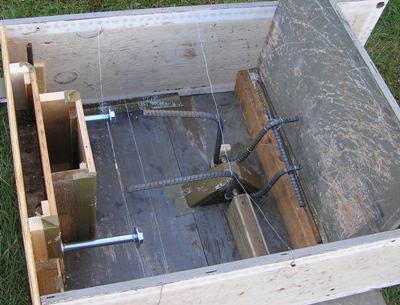
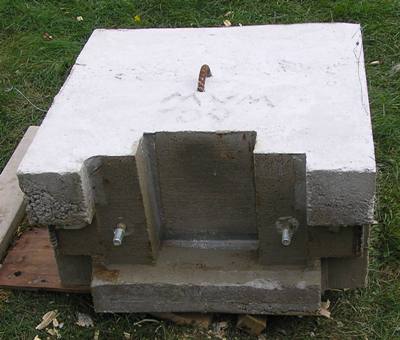
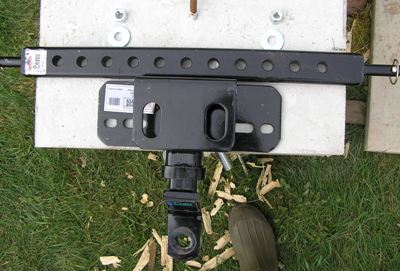

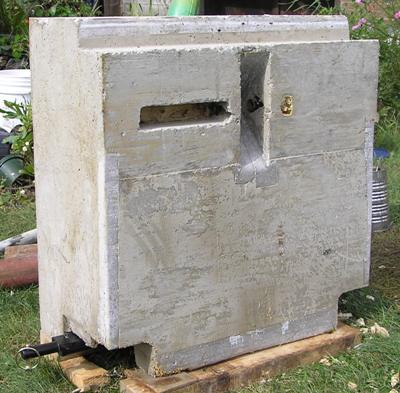
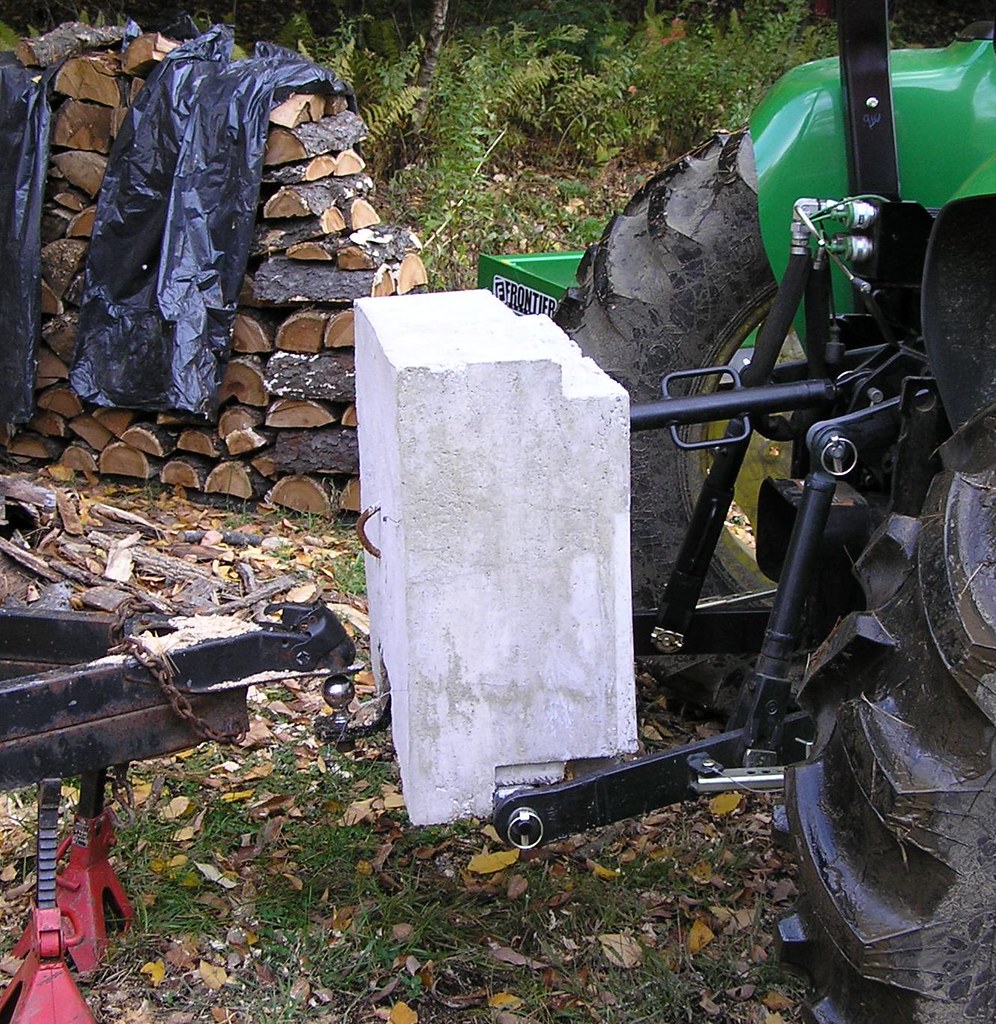
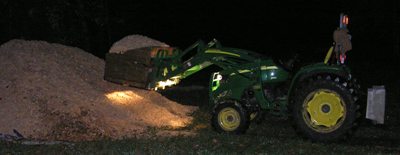


4 Comments:
Nifty tool. Probably easier to get on and off than what I use as a counterweight: the backhoe!
By Kurt, at 10:47 PM
Kurt, at 10:47 PM
A backhoe makes a hefty and flexible conterweight. You can even extend it out when you need more leverage.
Having one that works with my trailer has made life a lot easier for me, though. I have hauled in between 75 and a 100 loads of various materials with my trailer. Just the loss of a half cup of hydraulic fluid at each change over with the backhoe would have caused me to look elsewhere. But I would have gotten good at doing the change over...
Now I don't get tempted to test my weight limits when I don't have time to switch impliments.
By MMP, at 7:03 AM
MMP, at 7:03 AM
Just be careful about too much load across the body. I think this might be a contributing factor as to why my tractor broke in half, twice. The transmission case split. There appeared to be a flaw in the steel, they covered it under warrantee, where it split but it may have been a combo of the flaw and a lot of weight on the back and force front that made for the final failure. In my case, the backhoe was on both times and that weights 1,800 lbs if I remember correctly.
I also have the fluid in the rear tires. Does your tractor have that? I don't remember what the weight of that is, I think 800 lbs per tire but am not sure.
I'm surprised you're losing that much hydraulic fuel with the backhoe change over. I don't think I lose more than a couple of drops if that. On yours is it coming out the self-locking seals on the hose ends?
By Walter Jeffries, at 1:51 PM
Walter Jeffries, at 1:51 PM
WVJ, I am probably exhagerating the hydraulic fluid loss at a half cup. Its the fluid that is between the quick disconnects, enough to dribble out and maybe get on your hand during the exchange. But if I were trading the backhoe on and off each time I went from hauling the trailer to unloading it (more than 100 times this year) it would add up.
I definitely keep your experience with the transmission case in mind. I approach heavy lifting cautiously and take pains not to overload my lifting. I think you are right about the ~800lbs per tire for rimguard. It helps with traction for sure. I am looking to get about 1000 lbs total of counterweight with about half of that setup so I can backup to it and pick it up or drop it off without getting off the tractor. That way it is on only when I am doing those heavy lifting tasks.
By MMP, at 12:36 PM
MMP, at 12:36 PM
Post a Comment
<< Home